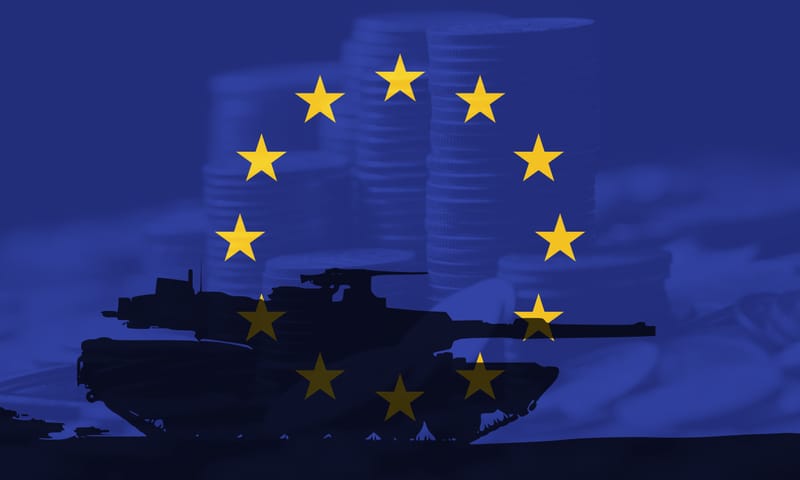Defense Pulse: Weekend, Arctic, Ukraine-Russia armistice revisited, Europe boils
I'm sending a late email in an attempt to salvage a consistent beat for defense pulse, which is important to my sanity as much as anything.
There is so much rampant action in the world and at home that I feel like I'm back in grade school math class in the eye of a hurricane storm. Given multipolarity, I meant to publish a "long weekend rundown," given that multipolarity gives way to more news and threats to consider for defense technology and address. But it was also a family celebration of my daughter's first birthday. I don't regret skipping the newsletter edition. That said, the rampant news of the world alarms me, as forces that counter democracy inch towards the ramparts of conventional conflict - every week.
But here's a rundown of what's happened since the last pulse. In short, with the Ukraine-Russia peace talks that will never be, the world's aggressive march has slowed its beat to a Bradycardic murmur. Bradycardia today for me; I went to the National Zoo for our daughter's first birthday, where we saw a couple of pandas.
DEFENSE PULSE — WEEKEND CATCH-UP → TODAY (Monday, August 11, 2025)
Front page
The planned Alaska meeting between Donald Trump and Vladimir Putin is now the center of gravity. People familiar with the back-channel talks say territorial “land-swap” ideas are being floated. European officials warn that any cease-fire without verification and enforcement would be a pause, not peace, and would give Moscow time to rebuild combat power. The anticipation of this event, along with the crescendo of other news, recovery from the last two weeks of international developments, has the world in a bradycardic state - on ice to rest before nation states take the mound for another inning of the multi-polar short-of-great-game(s).
Long Weekend Rundown (Friday–Sunday)
Russia–Ukraine cease-fire talks
Back-channel terms moved through Washington over the weekend. The broad outline is familiar from the Minsk era: freeze lines roughly where they are, ease sanctions in phases, and limit long-range fires for Ukraine. European capitals read it as a tactical pause.
Analysts expect Russia to rotate battered brigades off the line, rebuild artillery stocks, expand drone and electronic-warfare production, and harden its defense industry if a lull occurs.
NRSS: If there is an actual pause. It could be the pause, but far more faint, that was provided by the Germans' signing an armistice in the Compiègne Wagon that Hitler compelled the French to revisit for their armistice in World War 2 - the unpaused Great War. If Putin agrees to a pause, it's a tactical move, and where he does it will be purposeful. This meeting in Alaska hints at the Arctic's role in the Russian endgame.
Swiss F-35 turbulence
Switzerland’s plan to buy 36 F-35 fighter jets came under new pressure after a 39% U.S. tariff on Swiss goods and a fresh warning about higher program costs—roughly 1 billion francs more than expected. A motion to cancel remains active in Bern. Spain has already opted out of the F-35, and Portugal is reconsidering its path. The debate has shifted from picking a platform to managing sovereignty, industrial autonomy, and long-term sustainment risk.
Germany’s defense-tech flywheel
Germany’s defense-technology ecosystem accelerated. Notable moves include Project Q (software-defined battle management), ARX Robotics (unmanned ground vehicles for Ukraine), Quantum Systems (aerial intelligence, surveillance, and reconnaissance), and Helsing (a major growth round that pushed valuation into the double-digit billions of euros). Primes such as Rheinmetall and Hensoldt provide manufacturing scale and systems integration. Even auto tooling is redirected toward artillery components. The trend line is simple: Europe is rebuilding capacity at speed.
Arctic race, American gap
Congress funded the U.S. Coast Guard’s second and third Polar Security Cutters. Heavy icebreakers, however, are still slipping toward the early 2030s. Medium “Arctic Security Cutters” have been proposed to bridge the gap, with thicker hulls, endurance of nearly 12,000 nautical miles, and roughly 60 days at sea. Russia continues to dominate the icebreaker count, and China is advancing a nuclear-powered design.
Indo-Pacific signal remains
U.S. Indo-Pacific Command’s unfunded priorities list is about $11.9 billion, with more than $4.4 billion directed to unmanned systems across domains. The emphasis is on attritable aircraft, autonomous maritime systems, resilient sensing, and the logistics needed to move fuel and munitions under fire.
Latin America and the Caribbean pressure
The United States doubled its reward to $50 million for information leading to the arrest of Venezuelan leader Nicolás Maduro, citing a widening nexus between the state and transnational criminal groups. Mexico’s Sinaloa and Jalisco New Generation cartels continued violent turf contests. Brazil pushed back on new U.S. tariffs and signaled closer economic ties with China. The Organization of American States advanced a €1.4 billion stabilization concept for Haiti as a U.N. mission remained stalled.
Edge, space, and undersea
The U.S. military’s space architecture continues shifting toward a proliferated layer to keep communications and sensing resilient in wartime. Legacy weather-satellite feeds are being retired or replaced. The Navy’s next-generation attack-submarine program, SSN(X), slid into the 2040s, narrowing the U.S. undersea advantage unless Congress and industry accelerate schedules.
Defense Pulse Today (Monday) / Bradycardia
Alaska summit watch
Moscow is expected to press for a freeze map, sequencing for sanctions relief, and caps on long-range strikes. European officials say any deal must include inspection rights, intelligence-surveillance access, and automatic “snap-back” sanctions for violations. Without those tools, a cease-fire would function as a rearmament pause.
Europe’s posture hardens
Fighter purchases now double as industrial policy. Expect more European Union–sourced equipment and explicit offsets. Governments have been planning for mixed fleets for years. It looks like a play is interoperability from the start, not single-vendor stacks. The Europeans are set to be collaborative by nature compared to the US market by necessity.
Appropriations reality
The Senate’s defense topline sits near $852 billion, roughly $21.7 billion above the request. Money continues to flow to munitions, air and missile defense, shipyards, and posture in the Indo-Pacific. A continuing resolution remains likely, which means the pace of obligations and outlays will matter as much as the topline.
Army plus-up mechanics One-time injections total about $2.5 billion. Big lines include Maneuver Short-Range Air Defense (about $679.1 million), the Lower Tier Air and Missile Defense Sensor radar (about $634.5 million), and roughly $1.1 billion for the organic industrial base. The Patriot missile objective inventory is set to rise sharply—from about 3,376 to approximately 13,773.
Progress-payment chill in signal to industry to build & sell, not co-develop
The Defense Department’s pilot to flex progress-payment rates has been paused. Cash is tighter for primes and subcontractors. Expect harder milestone gates, stricter clawbacks for schedule slips, and a premium on programs that can show real throughput.
- NRSS: This is a bespoke program that many did not know much about. But, this is more of a trend, if not expectation, that the new administration does not want flaky contractors and is not inclined to give handouts for service-oriented work, even if it's developing capability. You are best suited to build independent, but with obsessive dedication to practical technical requirements.
- Method to GTM that is fast and deliberate, not flirtatious
- We are in a unique situation where your ability to communicate with the operators and users is more critical than your ability to play connect four bureaucrats at the Pentagon to get traction
- I don't know the exact moment it shifted, but - and this is an army-specific comment - they want bottom-up engagement
- Problem, that's still out of reach for outsiders, elites, and many who otherwise have top-down alacrity
- I don't know the exact moment it shifted, but - and this is an army-specific comment - they want bottom-up engagement
- We are in a unique situation where your ability to communicate with the operators and users is more critical than your ability to play connect four bureaucrats at the Pentagon to get traction
- The Venture method of producing a wedge product that gets a foot in the segment's door will not work with the unfolded timelines. Davidson window 2027-2032, but the conflict window is time now, and low-intensity conflict never stopped. You should build as if your nation is at war with counter-democratic forces because it is.
Edge communications and counter-drone. Disconnected operations are now routine. Mesh communications, jam-resistant positioning and navigation, and on-device artificial intelligence beat cloud-dependent designs in combat.
- Counter-unmanned aircraft systems remain layered: radio-frequency and electro-optical/infrared sensors to find drones; radio-frequency, high-power microwave, and kinetic effectors to stop them. Faster authority to employ those systems determines whether they work when it counts.
- effectors in bold because it is a good defense term of art to remember
Arctic logistics, this decade
Icebreaker schedules create real gaps. Priorities are seabed and cable monitoring, detection of spoofed maritime signals, pre-positioned fuel and ammunition, and hardened communications at key ports and chokepoints.
- This area will be a sleeper until it's not and bursts onto the everyday consciousness all at once—without more attention. Russia and China may come to rhetorical blows and consternation that tests the "limitless" partnership over Manchuria and access to the Bering Straight and Arctic Ocean. The Arctic represents hundreds of tribes without a uniform law, a unity of effort to govern economics and trade, and a burgeoning international legal framework design. It is as complicated as the early days of the Syrian civil war regarding the complexity of communities.
- PNT/Jamming, Information/Propaganda and other not kinetic PNT, Jamming, Information, Propaganda, and other non-kinetic quiet domains of warfare are poised to blare across the Arctic as it's disconnected, disjointed, and therefore vulnerable sects of communities, each with some integrity and bargaining chips.
- This matters because the Arctic is a new route for Russia to deliver weapons to the US and ghost fleet routes.
EUROPE — INDUSTRY (as of Monday)
- Rheinmetall
Second-quarter sales missed consensus on the timing of German awards (about €2.43 billion versus roughly €2.53 billion expected), but the company kept full-year guidance for sales growth of about 25% to 30%. Backlog sits around €63.2 billion at midyear, and management signals a larger book if Berlin awards land on schedule. Capacity expansions continue, including new ammunition lines in northern Germany. - Leonardo
Italy’s prime raised orders guidance to the €22-plus-billion range and lifted its free-cash-flow target to the high €900-million band. Net-debt guidance eased to roughly €1.1 billion. Revenue and EBITA guidance were unchanged, with execution and order intake carrying the year. - Saab
The Swedish group beat second-quarter expectations and raised 2025 sales-growth guidance to the high teens, about 16% to 20%. Double-digit organic growth continues on European rearmament. Management is expanding production and hiring. - Hensoldt
First-half sales rose about 11% to roughly €944 million on European demand. The company kept full-year revenue guidance near €2.5 billion to €2.6 billion. Radar and optronics are leading the performance. - BAE Systems
The British prime minister upgraded its full-year outlook after a strong first half, citing broad strength across the United Kingdom, the United States, and Saudi Arabia and progress on submarine and next-generation fighter programs. - Thales
The French group nudged 2025 sales-growth guidance higher after a solid first half. Defense and avionics led the performance; order intake was slightly lighter against last year’s unusually strong comparisons.
Investors & Startups
Build for a pause that may not last. Counter-electronic-warfare and counter-drone kits that can be fielded in weeks will move first. Decoys and deception at scale are back in fashion. So is intelligence fusion that still works when the cloud does not: ammunition throughput, air and missile defense, and unmanned systems—especially in the Pacific. Europe is hedging; products that translate and connect mixed fleets will beat bespoke solutions. With progress-payment flexibility on hold, milestone-tied deliverables matter more than slide decks.
My $.02
Either nations let things happen or they don’t. Let that idea inform how you view events in the world as you will. But in my relatively brief experience, I have found that in the world at the edge, where foreign policy cuts, we have limited influence over groups but can affect individuals. But groups and communities create waves that form destiny and drive posterity.
A cease-fire without teeth is a refit time for the next hit. Capacity—not rhetoric—decides what happens next. If you have an idea, a product, a plan that can play a role at war, in - pick a future theatre - build it now. And maybe get a GSA schedule to do so.






